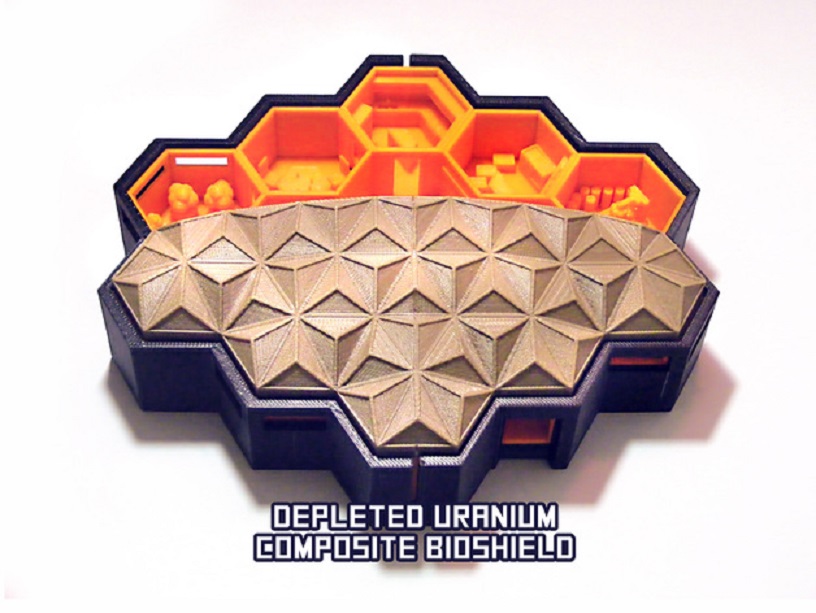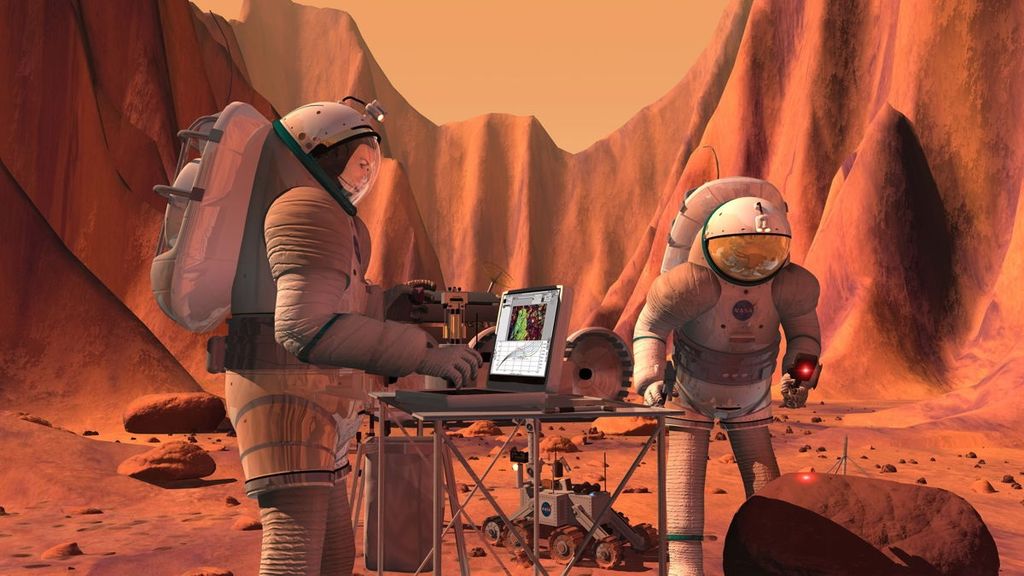
With NASA's proposed manned mission to Mars approaching, as well as crowdfunded initiatives like Mars One on the way, the idea of one day settling the Red Planet has been an important subject of late. And while the prospect of humans living on Mars has certainly inspired its fair share of skepticism, the fact that it is even being debated is very telling. For the first time in our history, the subject of how humans could or would live on Mars is being discussed as a serious possibility,
Naturally, setting down on the planet for the long-haul presents numerous challenges. In addition to its cold and dry environment, there are also frequent dust storms to contend with and the lack of breathable oxygen. To top it all off, the planet's thin atmosphere also means that the surface is routinely exposed to high levels of radiation. As such, any inhabitants on Mars would need to have spacious, accomodating, pressurized, and well-shielded living spaces in order to survive.
To tackle these challenges, and inspire new design concepts, Makerbot Thingiverse - a Brooklyn-based 3D printing company - came together with NASA's Jet Propulsion Laboratory to create the Mars Base Challenge. And incentive-based competition that ran from May 30th to July 12th, 2014, this challenge tasked students from all over the world to think about the particular challenges settlers would face on Mars and come up with practical and creative design solutions.

"What Will It Take to Live on Mars - Understanding Martian Resources and Environmental Constraints" Credit: NASA/JPL/Imagine Mars
The challenge received a total of 220 submissions, with the entrants being instructed to take into consideration Mars’ extreme cold, high radiation levels, lack of oxygen, and frequent dust storms. They were then told to design a utilitarian Mars base that could withstand the elements while at the same time making its owners feel at home - despite being 140 million miles away from Earth, on average.
The winning entries were awarded a MakerBot Replicator 2 Desktop 3D Printer in order to help them fully explore their designs for Martian abodes. Thingiverse also offered support along the way, printing out the designs themselves and offering handy hints in the comment section beneath each entry. These included how some designs would not survive in the Martian climate, or how its settlers would die a terrible, terrible death due to asphyxiation or exposure to radiation.
The top three winning concepts included the the Queen B (Bioshielding) 2 Bedroom 2 Bath Mars Apartment. Designed by Noah Hornberger, and relying on a honeycomb-style configuration, this modular "apartment fortress" was composed of hexagonal-shaped rooms that were fitted together and then shielded by a series of laminated, depleted uranium panels.

Model of the Queen B (Bioshielding) submission, by Noah Hornberger. Credit: Makerbot Thingiverse
Hornberger selected the flat-panelled, low-level design because he reasoned that it would be cheaper and easier to build in Mars' harsh environment. The hexagonal shape he chose for its natural durability and ease of assembly, with each module containing the basic amenities - bathrooms, bedrooms, living spaces, a kitchen, a 3D print lab, a decompression room, rooms for gardening - and snapping together to form a larger structure.
"I have extrapolated on the idea of a fully functional apartment on Mars with all the modern amenities fitted inside 16-foot-diameter hexagons," said Hornberger. "I think that to present Mars life to people and actually make it appealing to the public it needs to feel like home and reflect the lifestyle trends of Earth living."
The modular design also prevents heat loss, which is provided by an a combination of solar power collected by roof-mounted panels and an exothermic chemical reactor that also heats an underground water container. Excess steam produced by the heated water can also be used to drive generators around the home and supplement solar generations on days where dust storms are particularly bad.

Artist's concept for a potential Martian habitat. Credit: Mars One
Then there was the Martian Pyramid, a structure composed of mirror-based solar panels that collect energy and provide the inhabitants with vistas to help them combat feelings of isolation and enclosure. Inspired by the Pyramid of Giza, the structure is designed to withstand the worst of the elements while also being configured for science and engineering tasks and experiments.
It also comes with a nuclear generator to provide backup power, and water would be stored near the main power centre to heat it as needed. Food is created through a sustainable aquaponics system that sits at the top of the pyramid, where it is able to absorb sunlight to grow plants.
As it's creator, Valcrow, said: "The pyramid is one of the most iconic, long standing structures on earth, it's stable triangular geometry has proven itself through the ages in ancient buildings around the world and it's weather resistance in tent and teepee designs. This design focuses on looping essential systems into as many multi-functional roles as possible to ensure that the very limited resources are used and reused as much as possible."
And last, but not least, there was the Mars Acropolis, a futuristic design that uses carbon fibre, stainless steel, aluminum and titanium to create the main structure, while a combination of concrete, steel, and Martian soil help form the outer wall that protects the population.

Illustraion of The Mars Acropolis, by Chris Starr. Credit: Makerbot Thingiverse
The main structure consists of a foundation and three levels that accomodate different functions and facilities. On the ground level, decompression chambers protect against a loss of internal atmosphere, while a series of greenhouses grow the colonist's food and help filter the air and produce oxygen. Level one contains the water purifier while level two holds the living quartes, labs, and a landing dock where the colonists land and park their shuttles,
Meanwhile, level three acts as the nerve centre, with flight operators and observation posts, and the colony's huge water reservoir. As shown in the image above, this reservoir is situated at the very top of the settlement and reaches into the Martian sky, where it can collect atmospheric water, condense it for use by the inhabitants, and use the sun's energy to warm it.
As Chris Starr explained: "The structure serves as a mass research facility, to explore and develop means for additional colonisation of the planet. Due to the water vapour contained in the Martian atmosphere, that vapour can be harnessed into usable liquid water, where the condensation is collected from the water vapour, which is filtered back into the reservoir."

Concept art of Martian settlers performing scientific research on the surface. Credit: NASA/JSC
These and other entries were judged by a panel of experts from MakerBot and NASA's Jet Propulsion Laboratory, with the designs being assessed based on their scientific feasibility, creativity and printability. And while many of the entries did not always show a mastery of the science involved, they were undeniably novel and interesting. In addition, they were a testament to both the rapid-prototyping ability of 3D printing technology and the kinds of fresh thinking NASA is looking for.
In this respect, NASA's main goal in the competition - to spur interest in the prospect of one-day settling Mars - was a success. Given that human colonization of the Red Planet will likely come down to many waves of intrepid volunteers, and have a huge impact here on Earth, public interest is certainly desirable. In addition, the space agency has shown a great deal of interest in engaging the public in this age of renewed space exploration and reacing beyond its own scientists and engineers to come up with ideas.
Within the general public, there are countless people with the qualifications, drive, and imagination to come up with suggests for future missions, as well as ideas for Moon bases, spaceships, rovers, landers, and - in this case - Mars habitats. And given that they are dependent on public interest to ensure their funding for future exploration and research, opening the floor to public input can only be seen as a win-win situation.
Yes, by all accounts, it looks like we're definitely going to Mars. The only question is... will we stay there?
Top image: Makerbot Thingiverse
Sources:








